 |

|
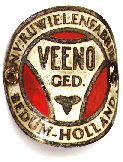 |
|
 |
| History |
1908: Pieter van der Veen Rzn., who
had come to Bedum to take care of the bicycle repair acivities at coppersmith Bodewes,
starts his own business in a barn at the backside of his home. Here he manufactures the
"Bedum" bicycle, works as a coppersmith, and sells, repairs, nickel-plates and
varnishes various parts. |
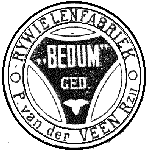
|
| 1911:
Although initially called "P.van der Veer Rzn., coppersmith and bicycle
manufacturer", the company for the first time has a real brand name: the
"Bedum" cycleworks. In 1912, a new "Bedum" bicycle would set you back
Hfl. 40,-, one year warranty included. 1917: Van der Veen builds a new factory at the
Noordwolderweg, the Veeno cycleworks. The name is the contraction of Van der Veen and the
extension "o", for the use of the name Bedum was no longer permitted because of
its geographical origin. The name had to consist of five letters considering the reserved
space on all parts. This new building features nickeling and enameling equipment, a
sandblowing machine, an automobile and engine repair shop and a warehouse. Furthermore,
cars can be hired "for rides". |

|
1920:
The company is converted to a public limited company, the "N.V. Rijwielenfabriek
Veeno". 1921:
Veeno makes six different (ladies' and gents') models: Express, Luxe A, Model A,
Model B, Model C1 and Model C2). The company's capacity is enhanced this
year, as in 1928, 1930, 1939 and 1957.
1923: Veeno introduces
the model Truck.
|
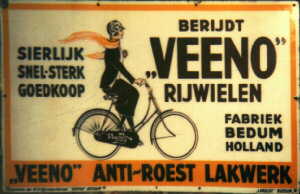 |
 |
| 1931:
By starting up their new modern chroming installation, Veeno is able to deliver all
nickel-plated parts in chrome. From approximately 1933 onwards, so-called
'Priests-bicycles' are available. This is a ladies' model with a frame longer than
regularly, so that nuns and priests can ride a bicycle without being bothered by their
robes. In the thirties, transport
tricycles appear for the first time. There are four varieties: bare (just the chassis),
open, with a closed box, and optionally even with an auxiliary engine.
|
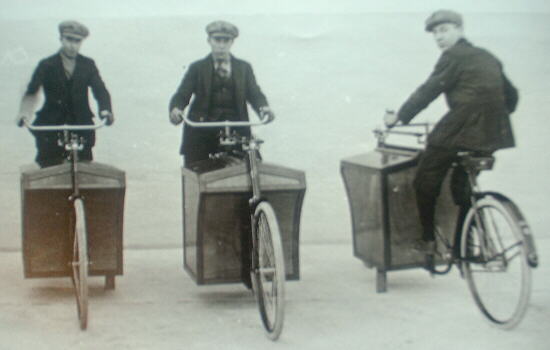 Veeno
delivery tricycle, basically of the same type like the Danish "Long John".
This bicycle features "Tors safety forks", a special Veeno construction.
The number of built bicycles of this type is probably very limited.
|
| New
in those days were the Tors and the Holfa ("Hollands Fabrikaat" = dutch made)
model. 1940: In
a letter to their customers Veeno politely requests to order as little as possible. Of
course, this has everything to do with the war. Like any other company, Veeno has trouble
finding material. In this period, the entire factory is looted by the German occupying
forces.
1953: R.J. van der
Veen, the founders' son, becomes a co-director of Veeno.
1958: In the
anniversary year, P. van der Veen Rzn., the 73 years old founder and director, deceases.
Of course, the planned festivities are cancelled because of this sad occasion.
Productionswise the sixties are Veeno's
best years. Veeno has a very strong reputation and their bicycles sell very good all over
the Netherlands. At this time, more than 100 employees are contracted and output is about
10.000 units per year. Well-known models are Rocket, Spirit, Veenolita and Toer Populair.

But soon Veeno encounters financial problems, just like most
of the other players in the bicycle industry. At September 24th, 1965 a moratorium of
payment is granted to Veeno. In 1966, the number of employees is down to approximately 35.
1967: This rescue
operation fails as well. On february 10th, 1967 the 'N.V. Rijwielenfabriek Veeno' is
declared bankrupt.
|
| 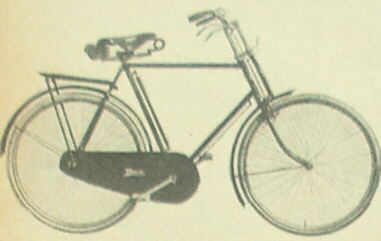
Veeno with Tors-forks
|
The
trade mark Veeno is taken over by Rijwielfabriek De Wilde in
Nieuwe Niedorp, along with the names Veenolite, Tors, Rocket, Holfa and Truck. This
framebuilder is declared bankrupt by the end of 1977. Van der Sluis company in
Surhuisterveen takes over the rights, but that company bankrupts after a fire in 1982. The
remains are taken over by Rivel in Surhuisterveen, which in turn is taken over by Union.
|
Although Veeno wasn't a big bicycle manufacturer, the good quality of their bicycles is
unquestionable. Some details from the fifties and sixties show that it was a rather
conservative manufacturer.

For example, they kept making bicycles with the solid 45-mm
Thompson bracket (Gazelle is the only one who used this bracket even longer on their
carrier bicycles). The fork with closed pads (eyelets) can be found on Veeno bicycles
until 1960(!). Finally, until approximately 1960 Veeno almost only made roadsters (28 x 1
1/2") instead of the cheaper smaller wheel-sizes. |
| Frame numbers |
As far as my information stretches
back, Veeno used only one series of straight forward numerical frame numbers, increasing
until app. 240,000 in 1967.
|
| Source |
Almost all information about Veeno is
provided by T.J. Matthijs from Bedum. He is a collector of documentation
and commercial material about Veeno, such as folders, pins, transfers, calendars, enamel
boards etc. If you think you might have or know something interesting for him, please
phone him at 0031-50-3014870. Translation by Dirk den Hamer. Thank you, Dirk! |
Have you got an old Veeno bicycle? Then
add the bicycle to the bicycle database and get feedback about
your bike. For more information click here.
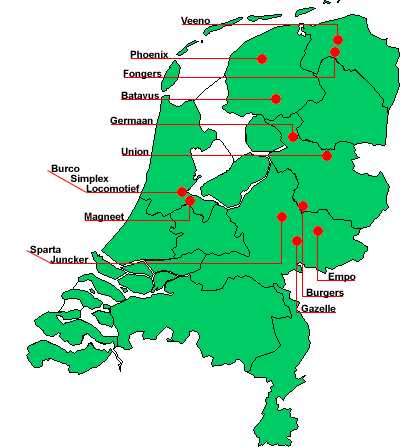
Copyright by Theo
Matthijs and Herbert Kuner, © 1999 ...
All rights reserved.

Last update: 17/12/2014
|